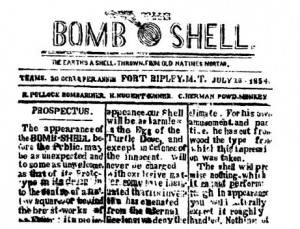If you’ve looked at my hectograph page, you might have guessed that I’ve always been intrigued by primitive printing methods. As that page shows, you can whip up a little printing press in the kitchen. According to Wikipedia (unfortunately, no sources are cited for the assertion), a hectograph was used by allied prisoners of war in World War 2 to make documents for a planned escape attempt.
A more laborious method was employed by three soldiers at Fort Ripley, Minnesota Territory, in the summer of 1854, when they published their newspaper the Bomb Shell. According to its masthead, the Bomb Shell is the handiwork of R. Pollock, the “Bombardier”, H. Nugent, the “Gunner”, and C. Herman, the “Powder Monkey”. It bears the motto, “the Earth’s a shell, thrown from old nature’s mortar.” The prospectus issue indicates a subscription rate of 50 cents per year, but there’s no indication that any issues other than the first, dated July 28, 1854, were ever dispatched from that mortar.
This newspaper is unique in that it was produced with hand-carved type. These early proto-bloggers didn’t let the lack of technology stand in their way. With a pocket knife, they carved out the type, set it by hand, and printed their own newspaper. According to its first issue, “the appearance of the BOMB-SHELL before the public may be as unexpected and to some as unwelcome as its prototype.” It goes on to say, however, that the new paper “shall be as harmless as the egg of the turtle dove and except in defense of the innocent, will never be charged with explosive matter.”
The editor of another Minnesota newspaper described it thus:
Its contents are lively, and entertaining but it is not on that account only, we desire to see “Bomb Shell” succeed. To the eyes, it is an uncouth, ill-printed, muddy-looking sheet, and every letter in it is larger than those in a child’s Primer–but all these drawbacks are more than compensated for, by the knowledge that all the letters and furniture used in setting up the paper, were made by one of the soldiers in the Fort, his principal tool to work with, being a small pocket knife. Those who know how necessary it is to accurately square and level types, to make them serviceable at all, will readily agree with us that this is a wonderful exercise of skill, patience, and ingenuity.
Minnesota Democrat, August 23, 1854, reprinted in Douglas C. McMurtrie, “The Printing Press Moves Westward,” Minnesota History, Vol. 15, No. 1, p. 24 (Mar. 1934) (available online).
I know there is one copy of the Bomb Shell in the collections of the Minnesota Historical Society, but it’s unfortunately not available online. In addition to the article cited above, the Bomb Shell is also referenced in Newspapers on the Minnesota Frontier by George Hage.

